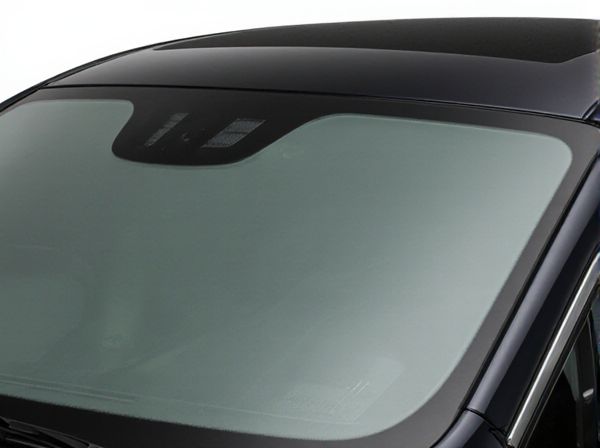
Photo illustration: Soundproof Windshield vs Standard Windshield
A soundproof windshield significantly reduces road and engine noise, enhancing your driving comfort compared to a standard windshield. It features laminated layers specifically designed to block and absorb sound waves, creating a quieter cabin environment. Your overall driving experience improves with better noise insulation, making long trips more enjoyable and less tiring.
Table of Comparison
| Feature | Soundproof Windshield | Standard Windshield |
|---|---|---|
| Noise Reduction | Up to 9 dB noise reduction, enhanced cabin quietness | Minimal noise insulation, higher external noise penetration |
| Glass Composition | Laminated glass with acoustic interlayer | Standard laminated glass without acoustic layer |
| Thickness | Typically 6.8 mm for sound deadening effect | Approximately 4-5 mm |
| Price | 15%-30% higher than standard windshield | Lower cost, widely available |
| Durability | Comparable strength and UV protection | Standard durability and protection |
| Installation | Requires professional fitting | Standard installation process |
| Ideal Use | Luxury vehicles, long-distance drivers, noise-sensitive users | General vehicles, budget-conscious buyers |
Introduction to Windshield Types
Soundproof windshields feature acoustic-laminated glass designed to reduce noise transmission, enhancing cabin quietness compared to standard windshields made with traditional laminated glass. These specialized windshields incorporate an inner acoustic interlayer that dampens external sounds such as traffic and wind turbulence. Standard windshields prioritize durability and basic safety, while soundproof windshields focus on improving in-cabin comfort by minimizing environmental noise.
What Is a Soundproof Windshield?
A soundproof windshield is engineered with layers of laminated glass combined with acoustic interlayers designed to reduce external noise by absorbing and dampening sound waves. Unlike standard windshields, which primarily consist of two layers of glass with a PVB interlayer for safety, soundproof windshields incorporate specialized acoustic materials that significantly decrease road, wind, and traffic noise inside the vehicle cabin. This advanced construction enhances driving comfort by creating a quieter and more serene environment, ideal for long trips or urban driving.
How Standard Windshields Work
Standard windshields are typically made from laminated safety glass consisting of two layers of glass with a polyvinyl butyral (PVB) interlayer, designed primarily for impact resistance and occupant protection. They reduce some road noise by providing a solid barrier, but their single-layer construction limits sound insulation compared to soundproof windshields. Standard windshields lack the specialized acoustic interlayers found in soundproof windshields that significantly diminish exterior noise such as wind, engine, and traffic sounds.
Key Acoustic Differences
Soundproof windshields utilize laminated glass with an acoustic interlayer designed to absorb and reduce noise frequencies from road, engine, and wind, significantly outperforming standard windshields in sound insulation. The acoustic interlayer often consists of polyvinyl butyral (PVB) or acoustic polyvinyl chloride (PVC), which dampens vibrations and minimizes sound transmission by up to 7 decibels compared to traditional tempered glass. This key difference results in a quieter cabin environment, enhancing driver comfort and reducing fatigue during long drives.
Noise Reduction Capabilities
Soundproof windshields utilize laminated glass with acoustic interlayers designed to absorb and block external noise, significantly reducing cabin sound levels compared to standard windshields. These specialized windshields can decrease noise by up to 50% or more, enhancing driver comfort by minimizing wind, traffic, and engine sounds. Standard windshields lack these acoustic properties, resulting in higher ambient noise penetration inside the vehicle.
Material Composition Comparison
Soundproof windshields utilize laminated glass with an interlayer of acoustic polyvinyl butyral (PVB) designed to absorb and reduce noise vibrations, whereas standard windshields typically consist of two layers of laminated glass with a basic PVB interlayer primarily for safety rather than sound insulation. The acoustic PVB in soundproof windshields features specialized molecular structures that enhance sound damping, significantly lowering cabin noise levels by up to 10 decibels compared to conventional designs. This material composition difference directly impacts driving comfort by minimizing external noise penetration without compromising windshield durability or clarity.
Benefits of Soundproof Windshields
Soundproof windshields significantly reduce external noise by incorporating laminated glass with specialized acoustic interlayers that absorb sound waves, enhancing in-cabin comfort. They improve driving experience by minimizing road, engine, and wind noise, which also reduces driver fatigue on long journeys. Compared to standard windshields, soundproof variants provide superior noise insulation without compromising visibility or safety standards.
Cost and Installation Factors
Soundproof windshields typically cost 20-40% more than standard windshields due to advanced laminated glass layers designed to reduce noise. Installation of soundproof windshields often requires specialized techniques and tools, potentially increasing labor costs and time compared to standard windshield replacement. Vehicle compatibility and availability of certified installers also influence overall expenses and installation ease for soundproof versus standard windshields.
Durability and Safety Considerations
Soundproof windshields feature laminated acoustic glass that enhances durability by reducing the risk of shattering upon impact compared to standard windshields, which typically use regular laminated or tempered glass. The multi-layer construction in soundproof windshields offers superior noise reduction while maintaining robust structural integrity, supporting better occupant protection during collisions. Safety considerations favor soundproof windshields due to their enhanced resistance to cracks and improved ability to absorb impact forces, contributing to increased passenger safety.
Choosing the Right Windshield for Your Needs
Soundproof windshields incorporate laminated glass with acoustic interlayers to significantly reduce road, wind, and traffic noise, enhancing cabin comfort compared to standard windshields. Standard windshields typically use tempered glass or basic laminated glass, offering durability and safety but less effective noise insulation. When choosing the right windshield, prioritize soundproof glass if you frequently drive in noisy environments or seek a quieter ride, while standard windshields suit budget-conscious drivers or those prioritizing impact resistance over noise reduction.
 caratoz.com
caratoz.com